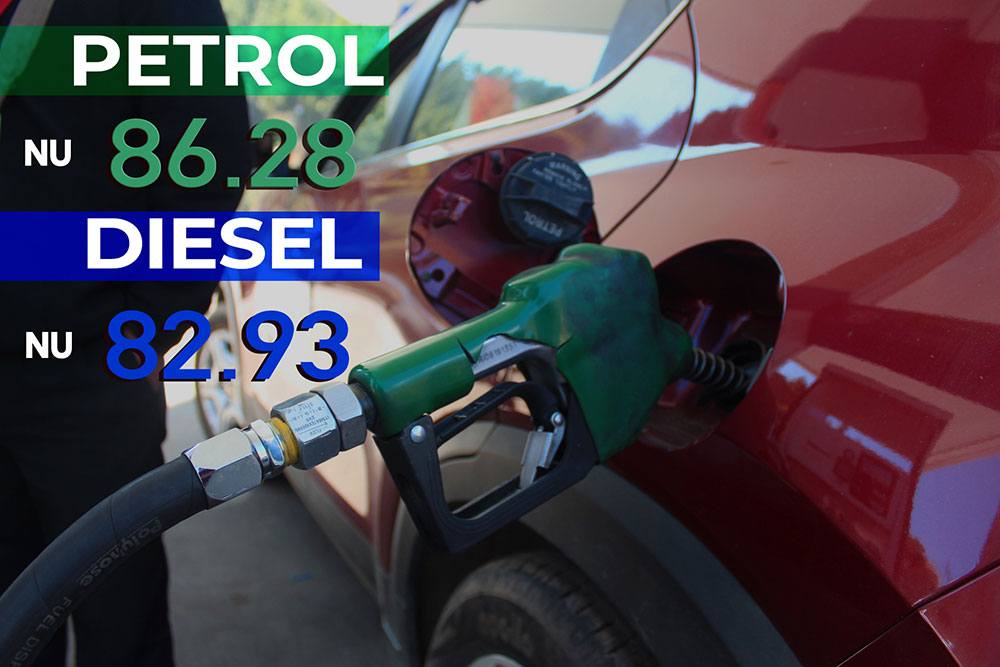Cost of fuel expected to rise to USD 110 a barrel by next year
Thukten Zangpo
The price of fuel has more than doubled since May of last year and is expected to increase further in the coming days, according to experts.
Prices are currently at a record high of Nu 86.28 a litre of petrol and Nu 82.93 a litre for diesel in Thimphu.
Prices for a litre of petrol and diesel have spiked by 89.9 percent and 118.9 percent respectively compared to May of last year when a litre of petrol was Nu 45.43. A litre of diesel then cost Nu 37.88.
Local economists said that the major hike in fuel prices is due to the reduction in oil production by the oil-producing countries.
An economist and managing director of Ugyen Trading Group, Damber S Kharka, said that fuel prices have increased because the consumption has remained almost the same, whereas supply has decreased as a result of reduced production.
Professor of Economics at Royal Thimphu College, Sanjeev Mehta, said that the global price of crude oil is affected by demand and supply factors.
“Since the middle of this year, demand for crude oil has gone up due to a shortage of coal and gas in China, India, and Europe. Petrol and diesel are used as an alternative for generating power. Besides, the OPEC countries have cut down on production,” he added.
OPEC refers to the Organization of the Petroleum Exporting Countries, which is a permanent intergovernmental organisation of 15 oil-exporting developing nations.
The production by five major suppliers, namely Saudi Arabia, United Arab Emirates, Russia, Iraq, and Kuwait, is 14 percent less than a year ago.
However, Sanjeev Mehta said the fuel prices are further inflated in India because of elevated taxes on petrol and diesel to pump government revenue in a Covid-19 affected fiscal situation.
“The fuel prices were about USD 38 per barrel in September 2020, and it has risen to USD 84 today. According to multinational investment bank and financial services provider Goldman Sachs, it may rise up to USD 110 per barrel next year,” he said, adding that there is no certain way to forecast fuel prices.
The hike in fuel prices has a cascading effect on the overall prices of commodities due to higher transportation costs. A higher cost of living tends to cut into real income, while the unemployment and poverty rates rise.
Sanjeev Mehta said,” Paradoxically, higher fuel prices affect those people who own vehicles less, and those who do not, more.”
He added that the reallocation of household budgets to manage the impact of rising fuel and overall prices contribute to welfare loss at the micro-level.
“Household savings also fall during this time. The poor and lower middle class are hit the worst,” Sanjeev Mehta said.
Similarly, Damber S Kharka said that consumers suffer more than the suppliers of goods as the increased fuel price increases the cost of goods supplied and the suppliers pass down most of the increased cost to the consumers in the form of increased prices.
He added that suppliers are also affected, as they won’t be able to sell more at the increased price.
“The poor people in the society such as low-paid jobholders, field workers with daily wages, and the farmers who need to buy basic necessities are among the ones who are worst affected,” Damber S Kharka said.
A popular wholesaler in Thimphu said that the increase in fuel prices could increase transportation costs from Phuentsholing to Thimphu by Nu 2,000 to Nu 3,000 per truck. He added that there would also be an increase in cost for transporting raw materials in the production units overseas and into the country.
A taxi driver, Wangchuk, said that earlier Nu 500 was enough to run for a day. “However, Nu 1,000 is barely enough now.”
A civil servant said that there was no way to escape the side-effects of the rise in fuel prices, as most civil servants depend on imports. He added that when a litre of petrol was Nu 50, Nu 1,500 was enough to fill the tank of an Alto car and could last for a month. “These days, I spend Nu 3,000.”
Yogesh Chettri, Manager at Damchen Petroleum fuel depot at Changzamtok, Thimphu said that despite the price hike, the number of cars refuelling has increased over the years. The depot sells around 1,700 litres of petrol and 3,200 litres of diesel in a day.
Damber S Kharka said that as an alternative to fuel, which is so volatile in its production and consequently the price, Bhutanese should shift to using electric vehicles.
“We have to encourage people to buy vehicles that run with green energy even if it means providing price subsidies and setting up more charging stations,” he said.
Sanjeev Mehta said that Bhutan needs to shift to alternative fuel, since the country depends on oil for imports, and its global prices are affected by a market that is highly volatile, making it extremely vulnerable to the balance of payment problems.
“We have to shift towards cleaner and cheaper hydropower that is feasible both technically and financially making us resilient and self-reliant,” he said.
As per the State Trading Corporation of Bhutan Limited, transporting a litre of petrol or fuel from Phuentsholing to Thimphu costs Nu 1.25. Currently, fuel prices are taxed 10 percent (5 percent green tax and 5 percent sales tax).
Bhutan has signed a memorandum of understanding with India to revise the fuel prices on the first and 16th day of every month, if there is change in the price.


